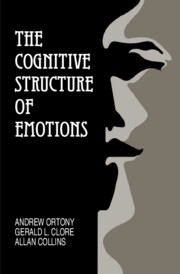Book contents
- Frontmatter
- Contents
- Preface
- 1 Introduction
- 2 The Structure of the Theory
- 3 The Cognitive Psychology of Appraisal
- 4 Factors Affecting the Intensity of Emotions
- 5 Reactions to Events: I
- 6 Reactions to Events: II
- 7 Reactions to Agents
- 8 Reactions to Objects
- 9 The Boundaries of the Theory
- References
- Author Index
- Subject Index
9 - The Boundaries of the Theory
Published online by Cambridge University Press: 01 June 2011
- Frontmatter
- Contents
- Preface
- 1 Introduction
- 2 The Structure of the Theory
- 3 The Cognitive Psychology of Appraisal
- 4 Factors Affecting the Intensity of Emotions
- 5 Reactions to Events: I
- 6 Reactions to Events: II
- 7 Reactions to Agents
- 8 Reactions to Objects
- 9 The Boundaries of the Theory
- References
- Author Index
- Subject Index
Summary
Any theory of emotion, whatever its focus, is likely to be bounded in the sense that there are aspects of the problem that it does not address and is not intended to address. Certainly, this is the case with the theory that we have proposed. We have chosen to focus on the cognitive antecedents of emotions because we think they play a crucial causal role in the experience of emotion. This focus has led us to concentrate on issues relating to the cognition–emotion interface while neglecting a host of other critically important questions. For example, physiology is essential for emotional experience but we have ignored it because it is not relevant to the question of the role that cognition plays in the elicitation of emotions. Nor have we taken a position on the role of facial expression in emotions. Such issues, while certainly important, simply are not ones that we have chosen to address. In this final chapter, we discuss some of the implications of the view of emotion that we have proposed with the goal of trying to show how and where we think they might be relevant to other issues. At the same time, this will give us an opportunity to identify some of the weaknesses in our approach that we ourselves recognize. This in no way, of course, precludes the possibility that there are other weaknesses that we have not recognized.
- Type
- Chapter
- Information
- The Cognitive Structure of Emotions , pp. 172 - 192Publisher: Cambridge University PressPrint publication year: 1988

